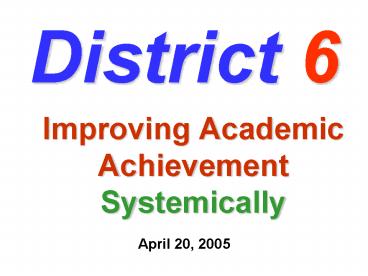District 6 - PowerPoint PPT Presentation
Title:
District 6
Description:
Title: Slide 1 Last modified by: DISTRICT J Created Date: 3/14/2005 2:18:51 AM Document presentation format: On-screen Show Company: LOS ANGELES UNIFIED SCHOOL DISTRICT – PowerPoint PPT presentation
Number of Views:83
Avg rating:3.0/5.0
Title: District 6
1
District 6
- Improving Academic Achievement Systemically
April 20, 2005
2
Outcomes for Today
- Introduce new administrative assignments in
District 6. - Share API progress for District 6 schools from
the base year, 1999-2000 to 2003-2004. - Read a portion of Wong-Fillmore Snow article on
What Teachers Need to Know about Written
Language.
3
Outcomes for Today
- Continue with the curriculum cycle of writing
(Gibbons, Ch. 4) using history/social science at
elementary and language arts at secondary as the
demonstration content areas. - Using site examples of elementary math journals
and secondary math charts to explore Gibbons
idea of moving from speaking to writing. (Chapter
3) - Discuss Operations matters.
4
District 6Academic Performance Index
State Rank Base
10 9 8
7 6 5 4 3 2 1
5
District 6 Historical API -- Elementary
Base 99-00 Base 00-01 Base 01-02 Base 02-03 Base 03-04 Base 04-05
700-750
650-700
600-650
550-600
500-550
450-500
400-450
350-400
300-350
1 16 8 2
1 14 8 2 1
11 11 4
2 8 11 3 1
7 12 5 1
1 7 11 4 1
6
District 6 Historical API -- Secondary
Base 99-00 Base 00-01 Base 01-02 Base 02-03 Base 03-04 Base 04-05
700-750
650-700
600-650
550-600
500-550
450-500
400-450
350-400
300-350
3 3
4 2
4 3
4 3
2 5
7
7
District 6
Academic Performance Index Comparisons 2000 to 2004
School Rankings School Rankings School Rankings School Rankings School Rankings School Rankings School Rankings School Rankings School Rankings School Rankings School Rankings School Rankings School Rankings School Rankings School Rankings School Rankings School Rankings
State Rank State Rank State Rank 2000 Base 2000 Base 2001 Base 2001 Base 2002 Base 2002 Base 2003 Base 2003 Base 2004 Base 2004 Base
10
9
8
7
6
5
4
3
2
1
8
Increased
Stayed the same
Decreased
9
District 6 Administrators Academy
L2 Content Reading Gibbons Using Gibbons
March 16, 2005 Writing Building academic language through a four-stage writing cycle Gibbons, Ch 4 Building the Field Modeling the Text Joint Construction Independent Writing Designing opportunities to develop writing using History/ Social Science within a productive group work format
10
District 6 Administrators Academy
L2 Content Reading Gibbons Using Gibbons
April 20, 2005 Writing Building academic language through a four-stage writing cycle Gibbons, Ch 4 Building the Field Modeling the Text Joint Construction Independent Writing Deepening opportunities to develop writing using History/ Social Science and language arts within a productive group work format
11
Teacher-Guided Reporting Develops Academic
Language.
- From Chapter 2
- Ask an open-ended question.
- SLOW DOWN the dialogue.
- Add wait time
- Allow more turns
- Respond to meaning.
- From Chapter 3
- Lead from behind.
- Push learner language.
- Recast and support.
12
Effective and Less Effective Writers (Gibbons, p.
52)
- Effective
- Plan before they begin to write
- Continually revise and edit
- Anticipate reader problems
- Are aware of linguistic differences between
speaking and writing - Know how to organize their ideas and writing as a
whole
- Less Effective
- Tend not to plan before writing
- Have difficulty in revising and editing.
- Less able to anticipate reader problems.
- Write as though they were speaking.
- Focus on mechanics and grammar
13
Gibbons, Chapter 4 (p. 58) Writing in a Second
Language
- ELL learners are less likely to be familiar
with the particular organizational structure of
different kinds of writing, and with the
grammatical structures of English. - A specific purpose
- A particular overall structure
- Connectives
- Specific linguistic features
- Relates to cultural relevance (Delpit)
14
So teach explicitly!! (p. 60)
- DONT
- Teach traditional grammar.
- Conduct meaningless drills and exercises.
- Separate listening, speaking, reading, and
writing into fragments.
- DO
- Reflect on how language is used.
- Look at purpose and audience.
- Encourage real-life use.
15
Gibbons Curriculum Cycle (pp. 60-67)
- Stage 1 (pp. 61-64)
- Building the Field
- Stage 2 (pp. 64-66)
- Modeling the Text Type
- Stage 3 (pp. 66-67)
- Joint Construction
- Stage 4 (p. 67)
- Independent Writing
16
D6 Modification of the Curriculum Cycle (pp.
60-67)
- Stage 1 (pp. 61-64)
- Building the Field
- Stage 2 (pp. 64-66)
- Modeling the Text Type
Modeled Writing
- Stage 3 (pp. 66-67)
- Joint Construction
- Stage 4 (p. 67)
- Independent Writing
17
District 6
- Adelante!
- Onward!































